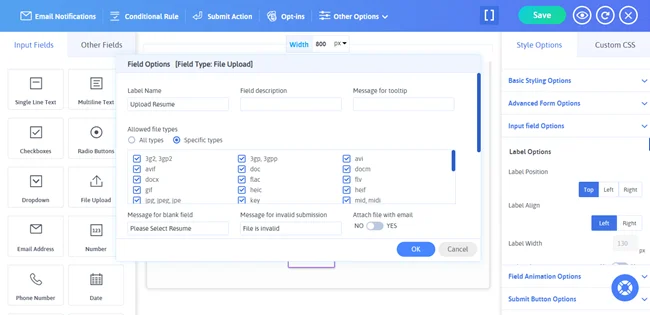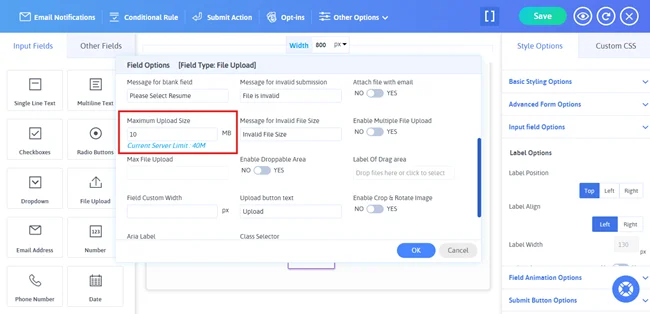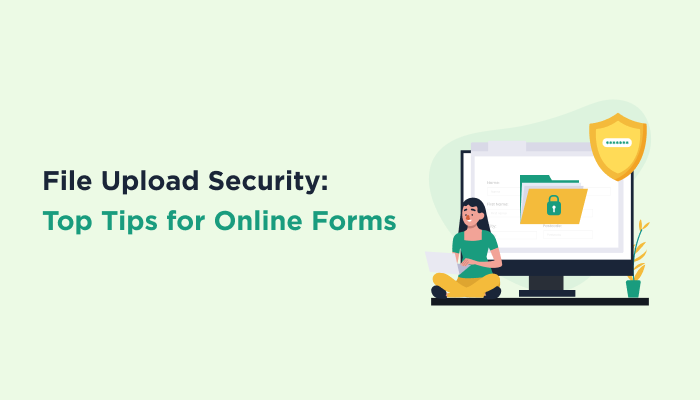File Upload Security: Best Tips for Online Forms in 2025
Adding a file upload field to your online form makes a lot of things easier. And adding it in your online form is even easier. File upload option in your online form can come very handy when creating job application forms, customer support forms, or assignment submission forms.
So if file upload online form is so useful, why do many businesses hesitate to use it? File upload vulnerabilities and security concerns!
Sharing and storing uploaded files collected from multiple website visitors comes with its own share of risks for businesses. You might end up facing yourself with malware, server overload, unauthorized access, or data breaches.
Yet, you don’t have to turn your back on the incredible benefits of a secure file upload. We have come up with the top file upload security tips for your online forms so you don’t miss out the chance of starting your own file upload form. Let’s get started.
Sometimes users might unintentionally or intentionally files which can harm your storage server. Before you could even realize, the malicious files might have hacked your server already. Thus, file upload security is important for online forms to stay secured and safe.
Imagine having an online contact form with a file upload field in your website. Now by default, WordPress stores all uploaded files in the wp-content/uploads folder on your server. Let’s say a hacker wants to attack your website and steal your customers’ data. So they come up as a regular website visitor and upload an image. At first glance, the image appears normal with the name “Screenshot123.jpg”. However, inside the file is a web shell, a small script that gives hackers backdoor access to your website’s server
The second you get that image file on your web server, the hacker will get access to run all kinds of commands on your server, making it super easy for them to get your customer’s data, system files and even cause your website to shut down.
That’s why file upload security is important for your online forms and business.
Here are some more benefits of file upload security for a secured file upload on your forms:
Now that we know how important file upload security is. It is time to check out the awesome file upload security tips and best practices to play it safe. Let’s dive in.
However, nowadays hackers are becoming smart. If your form accepts everything except a few executable files, hackers will surely find a way. So you have to be over smart to out smart the hackers by whitelist files types, not blacklist.
Instead of restricting or blacklisting a few specific files, use the whitelist trick. Only allows users to upload a few specific types of files only. Let’s say if you have a job application form with a file upload field. Add a small note on top of your file upload file which says, “Upload your CV (PDF only)”
Luckily, ARForms, an all-in-one WordPress form builder plugin, lets you restrict, blacklist, whitelist specific files types easily.
The best part? You don’t need any extra addon for these features. It offers 33+ customizable field types inside file upload field, email, signatures and more for creating a versatile WordPress online form. Moreover, it lets your user upload multiple files at lightning speed with AJAX submissions.

Simply to your file upload field, click the field setting. Now easily select the files you want to accept for your form submissions.
So the best way to tackle it is by setting a limit on your file upload.
With ARForms, Once again you have been given this option inside the File Upload Field’s settings. Just scroll a little and you can define “Maximum Upload Size” for your form.

Moreover, you can set the number of “Max File Upload” you want using the settings just beneath it.
Pro Tip: Always set a file size limit under what your web server can handle and your specific needs. For instance, if it’s a job application form, then you can set a limit of up to 5MB for users to upload their CVs.
In most of the scenarios, hackers are sneaky and name their files as “invoice.pdf.php”. It is a wolf disguised in sheep’s clothes because if your server executes this PHP file, it’ll be like inviting malicious code to run on your server.
The best practice and tip to prevent code execution is by using additional plugins or addons to configure your form builder to rename files on the time of upload. For example, if a user uploads a file named “resume.pdf”. Then it’ll be automatically converted to “upload-64se492.pdf”.
Moreover, by default all upload files to share are stored in /wp-content/uploads/ , so the chances of data leaks increases yet you don’t have to worry.
All you have to do is play extra safe and scan every single uploaded file for malware. Always store files in a non-public folder or popular cloud services. With this, even if hackers scan your server, they’ll find nothing, as you already secured your files.
Worth mentioning, ARForms simply populates your users all form entries into a Google Spreadsheet. You can also transfer your files into Google Drive via Zapier and automate your workflow effortlessly.
Pro Tip: Always scan uploaded files for malware before storing using a WordPress security plugin.
Don’t always chase the free WordPress plugins and themes, especially when creating your online form.
If you are using ARForms as your one and only form builder plugin for WordPress, no need to break a sweat. ARForms has been around for over a decade in this competitive WordPress market of plugins with over thousands of happy and safe customers.
That’s why, always encrypt your files with HTTPS. You can install an SSL certificate and force HTTPS as well.
You don’t have to wrack your brain with advanced and complex tech terms! Just know the simple difference that instead of http://myonlineforms.com/form, your form will transfer with https://myonlineforms.com/form.
This is a must if you are having an advanced form which deals with sensitive data. Forms such as payment forms, order forms, job application forms, tax submission forms, etc. must be encrypted with end-to-end security.
Although CAPTCHAs can interrupt the flow of form completion, they are often important to prevent bots from flooding your storage with unwanted files, taking up storage.
Well unfortunately for other users, it’s either this way or that way, but if you are using ARForms, you don’t have to worry. ARForms is your knight in shining armor, saving your users experience from the hassle of CAPTCHA and your storage from garbage files by offering Google reCAPTCHA.
The best part? The Google reCAPTCHA addon is absolutely free and seamlessly integrates with ARForms.
Moreover, ARForms cares for your online form and protects it with invisible spam protection. It is an intelligent spam protection mechanism that tracks any sus clicks and identifies the spam bots.
For your users to upload files online securely, you must take notes of all the best tips. To help you get to a conclusion, here’s are the quick smart ways to build secure online forms with file upload fields:
No need to think anymore! Make your file upload forms more secure with these top file upload security files and ARForms.
So if file upload online form is so useful, why do many businesses hesitate to use it? File upload vulnerabilities and security concerns!
Sharing and storing uploaded files collected from multiple website visitors comes with its own share of risks for businesses. You might end up facing yourself with malware, server overload, unauthorized access, or data breaches.
Yet, you don’t have to turn your back on the incredible benefits of a secure file upload. We have come up with the top file upload security tips for your online forms so you don’t miss out the chance of starting your own file upload form. Let’s get started.
Why is File Upload Security Important for Online Forms?
File upload security is all about protecting your business’s website and server from malicious or malware files. If you have a field upload field in your online form or website, obviously multiple users will upload files. Now some files might be useful but not all are safe.Sometimes users might unintentionally or intentionally files which can harm your storage server. Before you could even realize, the malicious files might have hacked your server already. Thus, file upload security is important for online forms to stay secured and safe.
Imagine having an online contact form with a file upload field in your website. Now by default, WordPress stores all uploaded files in the wp-content/uploads folder on your server. Let’s say a hacker wants to attack your website and steal your customers’ data. So they come up as a regular website visitor and upload an image. At first glance, the image appears normal with the name “Screenshot123.jpg”. However, inside the file is a web shell, a small script that gives hackers backdoor access to your website’s server
The second you get that image file on your web server, the hacker will get access to run all kinds of commands on your server, making it super easy for them to get your customer’s data, system files and even cause your website to shut down.
That’s why file upload security is important for your online forms and business.
Here are some more benefits of file upload security for a secured file upload on your forms:
- Avoids and prevents malicious code execution
- Saves your web server from malware and viruses
- Protects your system from Dos or DDoS attacks
- Ensures privacy and data confidentiality
- Protect users data from unauthorized access and breaches
- Saves your business from any reputational damage
Now that we know how important file upload security is. It is time to check out the awesome file upload security tips and best practices to play it safe. Let’s dive in.
File Upload Security: Best Practices for Online Forms
Whitelist File Types, Don’t Blacklist
Now restricting a few specific types of files is a good way to protect your online forms. Mostly hackers upload files such as “.exe”, “.php”, or ”.js” disguised as regular documents. Thus, almost everyone is told to restrict these specific types of files on your file upload form.However, nowadays hackers are becoming smart. If your form accepts everything except a few executable files, hackers will surely find a way. So you have to be over smart to out smart the hackers by whitelist files types, not blacklist.
Instead of restricting or blacklisting a few specific files, use the whitelist trick. Only allows users to upload a few specific types of files only. Let’s say if you have a job application form with a file upload field. Add a small note on top of your file upload file which says, “Upload your CV (PDF only)”
Luckily, ARForms, an all-in-one WordPress form builder plugin, lets you restrict, blacklist, whitelist specific files types easily.
The best part? You don’t need any extra addon for these features. It offers 33+ customizable field types inside file upload field, email, signatures and more for creating a versatile WordPress online form. Moreover, it lets your user upload multiple files at lightning speed with AJAX submissions.

Simply to your file upload field, click the field setting. Now easily select the files you want to accept for your form submissions.
Limit File Size to Prevent Server Overload
Large files can slow down your website. Sometimes users by mistake upload large files like a 100MB video when your server can handle only 10MB. Moreover, hackers might upload large sized files to slow your server. This is a very common trick known as DoS via file upload yet you don’t have to worry.So the best way to tackle it is by setting a limit on your file upload.
With ARForms, Once again you have been given this option inside the File Upload Field’s settings. Just scroll a little and you can define “Maximum Upload Size” for your form.

Moreover, you can set the number of “Max File Upload” you want using the settings just beneath it.
Pro Tip: Always set a file size limit under what your web server can handle and your specific needs. For instance, if it’s a job application form, then you can set a limit of up to 5MB for users to upload their CVs.
Rename Files Automatically to Prevent Code Execution
Automatic renaming files right after they are uploaded in the form is a safety precaution.In most of the scenarios, hackers are sneaky and name their files as “invoice.pdf.php”. It is a wolf disguised in sheep’s clothes because if your server executes this PHP file, it’ll be like inviting malicious code to run on your server.
The best practice and tip to prevent code execution is by using additional plugins or addons to configure your form builder to rename files on the time of upload. For example, if a user uploads a file named “resume.pdf”. Then it’ll be automatically converted to “upload-64se492.pdf”.
Store Files Outside the Public Web Directory
As we said before, cybercriminals are smart. They are proficient in disguising malicious files as legitimate uploads.Moreover, by default all upload files to share are stored in /wp-content/uploads/ , so the chances of data leaks increases yet you don’t have to worry.
All you have to do is play extra safe and scan every single uploaded file for malware. Always store files in a non-public folder or popular cloud services. With this, even if hackers scan your server, they’ll find nothing, as you already secured your files.
Worth mentioning, ARForms simply populates your users all form entries into a Google Spreadsheet. You can also transfer your files into Google Drive via Zapier and automate your workflow effortlessly.
Pro Tip: Always scan uploaded files for malware before storing using a WordPress security plugin.
Use Trusted WordPress Plugins and Themes
This is one of the top tips we’ve ever given and always give. Always use trusted WordPress plugins and themes. If not, no matter how many precautions, best practices or tips you follow, it’ll be no use, but you don’t have to worry.Don’t always chase the free WordPress plugins and themes, especially when creating your online form.
If you are using ARForms as your one and only form builder plugin for WordPress, no need to break a sweat. ARForms has been around for over a decade in this competitive WordPress market of plugins with over thousands of happy and safe customers.
Always Encrypt File Transfers with HTTPS
Transferring files with HTTP is like transferring gold from one country to another with no security. Anyone can easily steal it or in technical terms, intercept the mid-transfer.That’s why, always encrypt your files with HTTPS. You can install an SSL certificate and force HTTPS as well.
You don’t have to wrack your brain with advanced and complex tech terms! Just know the simple difference that instead of http://myonlineforms.com/form, your form will transfer with https://myonlineforms.com/form.
This is a must if you are having an advanced form which deals with sensitive data. Forms such as payment forms, order forms, job application forms, tax submission forms, etc. must be encrypted with end-to-end security.
Add CAPTCHAs to Prevent Spam Uploads
Bots and robots love online forms. That’s the reason you must have come across multiple “Verify your are not robot” messages and CAPTCHAS everywhere.Although CAPTCHAs can interrupt the flow of form completion, they are often important to prevent bots from flooding your storage with unwanted files, taking up storage.
Well unfortunately for other users, it’s either this way or that way, but if you are using ARForms, you don’t have to worry. ARForms is your knight in shining armor, saving your users experience from the hassle of CAPTCHA and your storage from garbage files by offering Google reCAPTCHA.
The best part? The Google reCAPTCHA addon is absolutely free and seamlessly integrates with ARForms.
Moreover, ARForms cares for your online form and protects it with invisible spam protection. It is an intelligent spam protection mechanism that tracks any sus clicks and identifies the spam bots.
Conclusion: Smart Way to Build Secure Online Forms
In a nutshell, File upload security is a must in today’s digital era where you want both; benefits of upload file forms and security from hackers.For your users to upload files online securely, you must take notes of all the best tips. To help you get to a conclusion, here’s are the quick smart ways to build secure online forms with file upload fields:
- Always allow your users to only upload specific and necessary types of files.
- Set a limit on the file size you want users to upload and if possible, add a custom message too.
- Store uploaded files on cloud
- Always use trusted WordPress plugins and themes
- Transfer and encrypt files via HTTPS
- Add an extra layer of security with Google reCAPTCHA.
No need to think anymore! Make your file upload forms more secure with these top file upload security files and ARForms.



